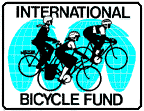Bicycles & Urban Traffic in Africa

![]() IBF is 100%
IBF is 100%
solar powered
![]()
Transportation Patterns In Nairobi And Programs To Improve Opportunities For Bicycling
"Transportation Patterns In Nairobi And Programs To Improve Opportunities For Bicycling," by Njagi Gakunju and David Mozer, looks at the history of transportation in Nairobi that has lead to the present day traffic jams and deteriorating air quality; why bicycling has decreased since independence; and what might be done to encourage a more peoplefriend and environment friendly transportation program in the city.
In their analysis, Gakunju and Mozer write, "The coffee boom of the 1970's brought a mushrooming of housing estates in the rural areas near the city. Fast bucks were made, but as planned communities they have failed. All services are far away. Houses were put up, but no schools, clinic, post offices, fire stations or employment centers were built. Even during this period of plenty no provisions were made to develop bicycle paths or even footpaths. Because the suburbs lack schools, parents are forced to crisscross the city with their children to deliver them to school in the morning and pick them up in the afternoon. Every day thousands of work hours are lost in the process of dropping kids off and picking them up. There are virtually no school buses. Every development was directed towards the automobile a pattern that prevails to the present."
![]()
Table of Contents
- Introduction
- Pre-Industrialization
- Independence And Transportation Colonialism (not included in online version)
- Community Reaction (not included in online version)
- New Developments (not included in online version)
- Agenda For The Future (not included in online version)
Introduction
Nairobi calls itself the "Green City In The Sun," but now the leaves are black with motor-vehicle exhaust soot and the sun is filtered through a brown haze on many days. Year-by-year there is increasing congestion, decreasing air quality and a lengthening list of social problems. Most of the actions exposed in the current debate fail to address the social problems, would do little to clear the air and are the old tried and failed solutions for "solving" congestion. Where does the city stand today, and are there any workable strategies to improve the quality of life?
Pre-Industrialization
Nairobi was built at the turn of the century. It expanded out of a work camp of the Mombassa/Uganda railroad. At that time the primary means of heavy transport was ox-wagons. Consequently the roads were designed for slow-moving traffic.
Since those humble beginnings, few major changes have been made to the road grid in the central city. As the population has grown and sophistication of transport technology has progressed the city's roads have become choked with motor-vehicles of a kind and in numbers never initially envisioned.
For many decades the problem was manageable. Through the first part of the century the largest employers in the city were government departments and corporations like the railways. These organizations, perhaps unwittingly, played a part in keeping the congestion to a minimum by encouraging their workers to use bicycles to travel to work. The government even built some bicycle paths. In those days, employers were even required to provide parking facilities for bicycles. To this day you can see some of these lying unused outside some of the older government buildings.
Home | About Us | Contact Us | Contributions | Economics | Education | Encouragement | Engineering | Environment | Bibliography | Essay Contest | Ibike Tours | Library | Links | Site Map | Search
![]()
The International Bicycle Fund is an independent, non-profit organization. Its primary purpose is to promote bicycle transportation. Most IBF projects and activities fall into one of four categories: planning and engineering, safety education, economic development assistance and promoting international understanding. IBF's objective is to create a sustainable, people-friendly environment by creating opportunities of the highest practicable quality for bicycle transportation. IBF is funded by private donation. Contributions are always welcome and are U.S. tax-deductible to the extent allowed by law.
![]()
![]() Please write if you have questions, comment, criticism, praise or
additional information for us, to report bad links, or if you would like to be
added to IBF's mailing list. (Also let us know how you found this site.)
Please write if you have questions, comment, criticism, praise or
additional information for us, to report bad links, or if you would like to be
added to IBF's mailing list. (Also let us know how you found this site.)
